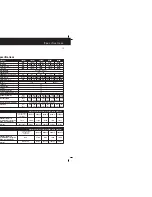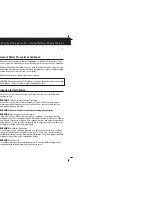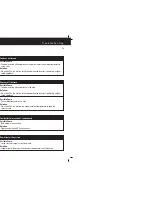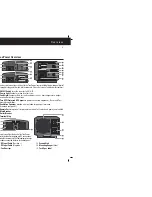
Connecting the DC Cables
DC connections must be securely fastened and all connections must be tight to avoid risk
of fire. Connect the DC cables from the inverter to the battery as noted in the following steps:
1. Switch the On/Off switch to the Off position.
2. Route the DC cables from the inverter toward the battery.
3. For an ABYC E-11 compliant installation, connect a customer supplied DC fuse or
circuit breaker in the positive side of the circuit within 7 inches of the battery. This
protects your battery and wiring in case of an accidental shorting (Please see
Specifications Table in this Manual for correct sizing).
4. Open the DC fuse or turn off the circuit breaker.
5. Install one connector on the POSITIVE (+) cable to the POSITIVE DC terminal on the inverter.
6. Install the other connector to the POSITIVE (+) terminal DC fuse or DC circuit breaker. Use
a wrench to tighten the connection. Test that the cable is secure and the connection is tight.
7. Attach a short DC cable from the unconnected end of the DC fuse or DC circuit
breaker. Tighten appropriately.
8. Observing polarity carefully, connect the end of the fused cable to the POSITIVE (+)
terminal of the battery. Tighten this connection to the battery manufacturer’s recommended
torque. You may replace the fuse now or turn the DC circuit breaker on.
9. Connect one connector on the NEGATIVE (-) cable to the NEGATIVE (-) battery terminal.
Tighten the connection and assure the cable is secure.
10. Check that the polarity of the DC connection is correct: positive (+) on the inverter is
connected to the positive (+) on the battery and negative (-) is connected to the negative (-).
IMPORTANT: The next step is the last cable connection you will need to make in mounting
the TruePower inverter. A spark is normal when this connection is made!
11. Connect the other connector of the NEGATIVE (-) cable onto the NEGATIVE (-) terminal
on the TruePower Inverter.
12. Use a wrench to tighten the nut. Test that all cable connections are tight.
Connecting The AC Hardwire
The 2000, 2500 and 3000watt models have a Terminal strip, located on the front panel,
allow a qualified electrician or professional installer to bring in 1 or 2 AC hardwires
consisting of a line, neutral and ground wire (L,N,G). The 2000 and 2500 watt models
require a 12 gauge hardwire, while the 3000w model requires a 10 gauge wire.
All
outlets installed remotely to this hardwire connection must be GFCI receptacles,
or remotely GFCI protected.
9
I n s t a l l a t i o n G u i d e l i n e s
10
Te s t i n g Yo u r I n v e r t e r
Performing Checks Prior to Operation
Before starting up your inverter, ensure these conditions are met:
Verify the On/Off switch is in the Off position
Verify the Positive (+) battery cable is connected to the positive (+) battery terminal.
Verify the Negative (-) battery cable is connected to the negative (-) battery terminal.
Verify the battery voltage is within the proper range for this unit (roughly 10-15.5 volts DC).
Verify the DC fuse is in tact.
Testing Installation
When you are ready to test your installation and operate the TruePower Inverter, close
the DC fuse or the DC circuit breaker to supply DC power to the TruePower inverter.
Display Functions of the LED Light Pattern:
The ON/OFF switch turns the TruePower inverter to ON or to OFF:
- In the On position, the Inverter Power LED light illuminates Green. The TruePower begins
inverting and provides AC power.
- In the Off position, the TruePower Inverter draws no current from the battery. None of
the front panel LED lights are illuminated.
- The Fault Light Illuminates Red when a fault conditions such as over temperature, output
overload, or battery low voltage occurs.
To test the TruePower Inverter:
1. Turn the On/Off switch to the ON position.
The Inverter/Fault LED light illuminates Green.
2. Plug an appliance of equal watts or less into the AC outlet.
3. Turn the appliance ON to verify that it operates.
If the Inverter/Fault light illuminates Red, see the TruePower Inverter “Troubleshooting”
section.
Testing of the GFCI
1. Turn the On/Off switch to the ON position.
2. Plug a test lamp into the GFCI outlet.
3. Press the “test” button located on the GFCI outlet.
4. The “reset” button should pop out and the power to the test lamp should turn off. If the lamp
does not shut off and remains on, or if the reset button does not pop out, the GFCI receptacle
is defective. Please call factory service at 1-800-824-0524 for replacement or service.
5. To resume regular operation, push the “reset” button to return to regular operation.





























